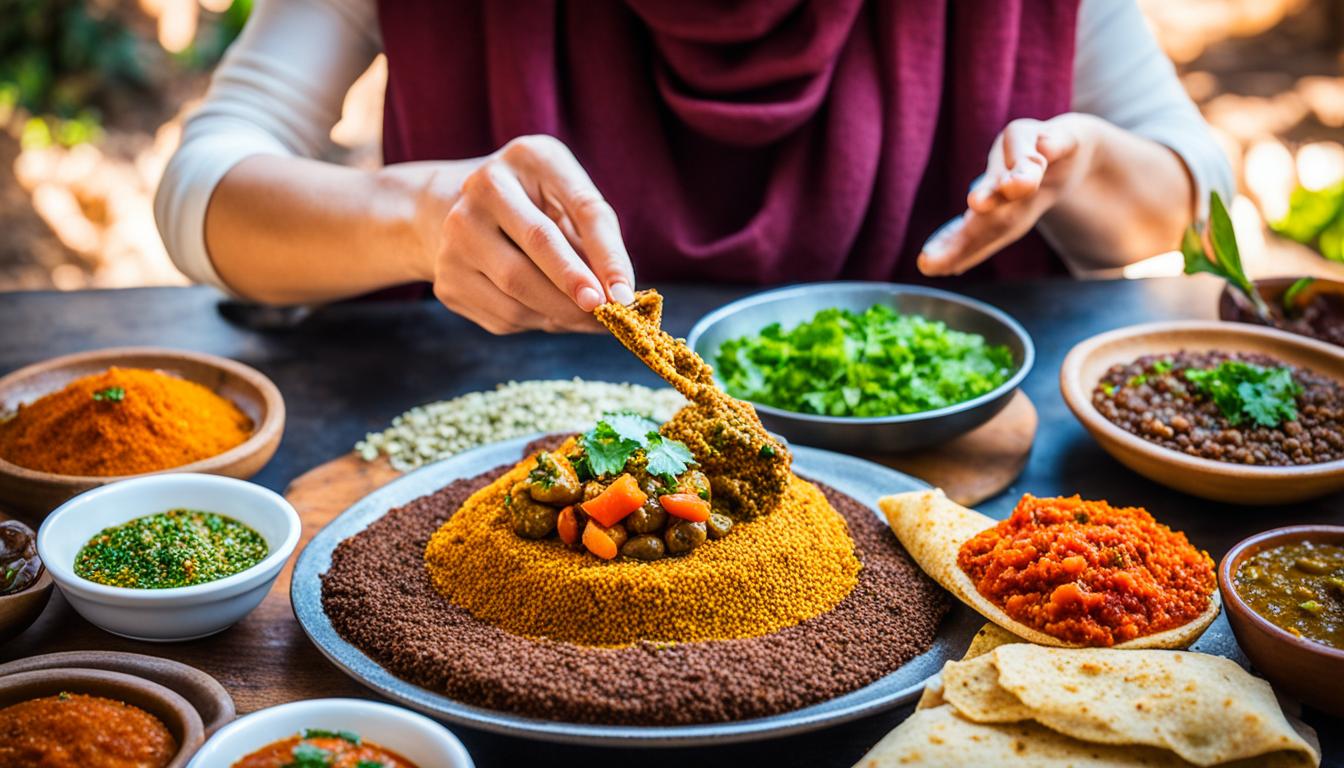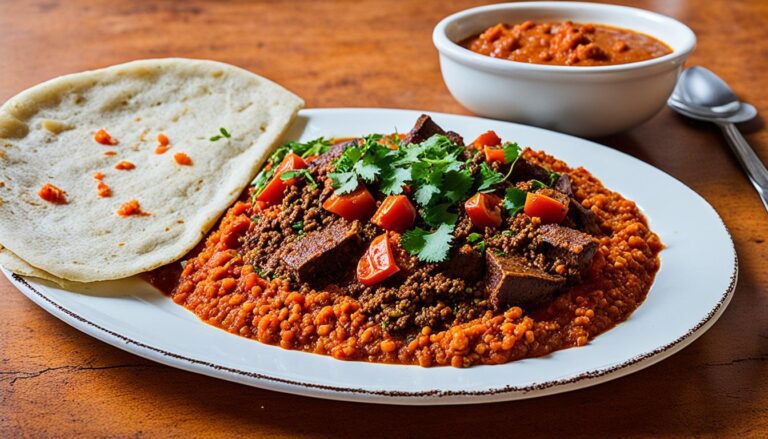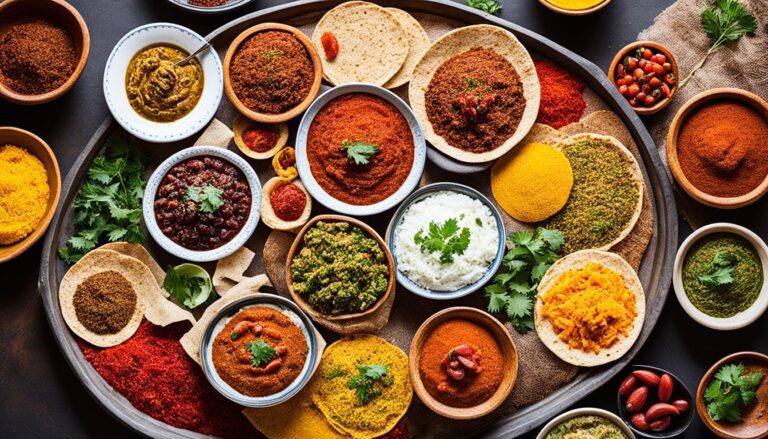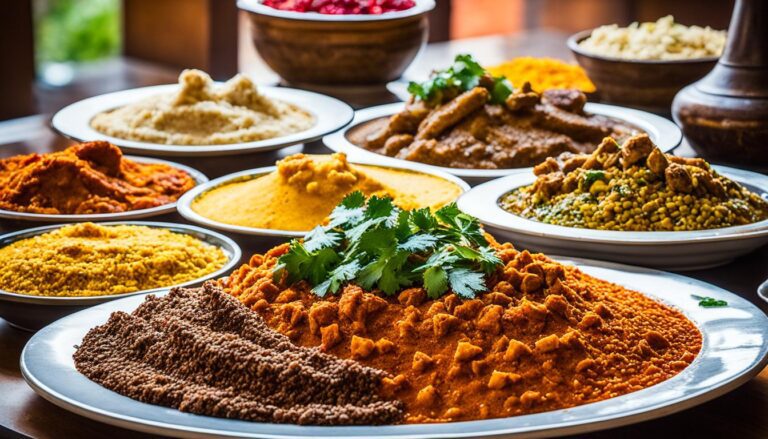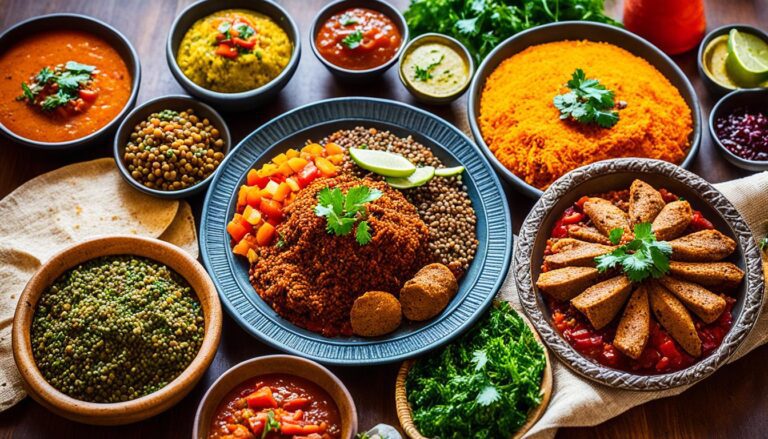What Hand Do You Eat Ethiopian Food With?
Have you ever wondered how Ethiopian food is traditionally eaten? It’s a cultural journey that involves a unique dining tradition and a handpicked utensil.
Ethiopian cuisine is known for its rich flavors and vibrant spices, but the way it is enjoyed goes beyond just the taste. Ethiopian food is traditionally eaten with the hands, using injera bread as a utensil. But which hand do you eat with? That’s the intriguing question we’re exploring in this article.
Key Takeaways:
- Ethiopian food is traditionally eaten with the hands, using injera bread as a utensil.
- The right hand is the customary hand to eat with, while the left hand is considered unclean.
- Mealtime etiquette in Ethiopia involves washing hands before and after the meal and showing respect by allowing elders to begin eating first.
- Understanding Ethiopian dining traditions and etiquette enhances the authenticity of the culinary experience.
Ethiopian Dining Tradition
Ethiopian dining tradition is a unique and hands-on affair that brings people together. When it comes to Ethiopian cuisine, communal eating is the norm. Picture a large communal plate, reminiscent of a pizza pan, placed at the center of a gathering of friends and family. This communal plate is where the magic happens, where everyone shares the food and connects on a deeper level.
Before diving into this communal plate, it is essential to ensure cleanliness by washing our hands. In Ethiopian culture, the left hand is considered unclean, so we must use our right hand for handling food. This cultural practice emphasizes the importance of maintaining cleanliness during mealtime.
Ethiopian cuisine is known for its variety of flavors and textures, and injera bread plays a central role in the dining experience. Injera, a spongy and tangy bread made from teff or other grains, is used as a versatile utensil to scoop up food from the communal plate. With injera in our hands, we bring the delectable morsels of food to our mouths, savoring each bite of this unique and flavorful cuisine.
Mealtime Etiquette in Ethiopia

Ethiopian mealtime etiquette encompasses a range of customs and practices that reflect the country’s rich cultural heritage. Central to this etiquette is the importance of handwashing before and after a meal. Cleanliness is highly valued, and some hosts even provide a basin and pitcher of water with soap for guests to use at the table. This practice not only ensures hygiene but also demonstrates respect for one another.
Another intriguing aspect of Ethiopian mealtime etiquette is the gursha gesture, a meaningful act of friendship and respect. During a meal, someone might place a small morsel of food into another person’s mouth as a token of goodwill. This intimate gesture fosters a sense of connection and camaraderie, further enhancing the dining experience.
In Ethiopian culture, respect for elders is paramount. It is customary to allow the eldest person present to begin eating before the rest of the group. This gesture shows deference and acknowledges the wisdom and experience that come with age. If you find yourself as the oldest person at the table, others will patiently await your cue to begin the meal, an act that further emphasizes Ethiopian values of respect and honor.
By adhering to these mealtime etiquette practices, we not only show our appreciation for Ethiopian culture but also contribute to the overall sense of harmony and respect during communal dining experiences. These customs foster a deeper understanding of Ethiopian traditions and create memorable shared moments that transcend cultural boundaries.
Eating Techniques for Ethiopian Food
When it comes to enjoying Ethiopian cuisine, it’s important to follow specific eating techniques. In Ethiopian culture, the right hand is the preferred hand for handling food, as the left hand is considered unclean. So, remember to always use your right hand when indulging in the delicious flavors of Ethiopian dishes.
Avoid licking your fingers while eating. Not only is it seen as gross, but it can also potentially spread germs. Instead, keep a napkin or a piece of injera bread handy to wipe your fingers clean and maintain proper hygiene.
Another important etiquette to keep in mind is to avoid reaching across the table for food. This is considered rude in Ethiopian culture. Instead, wait for others to finish before politely requesting food that is not within your reach. Respect for others’ personal space and the communal dining experience is highly valued.
Remember, by using your right hand, avoiding finger licking, and refraining from reaching across the table, you can fully immerse yourself in the cultural experience of Ethiopian dining and show respect for the customs and traditions of the Ethiopian people.
Ethiopian Food and Injera
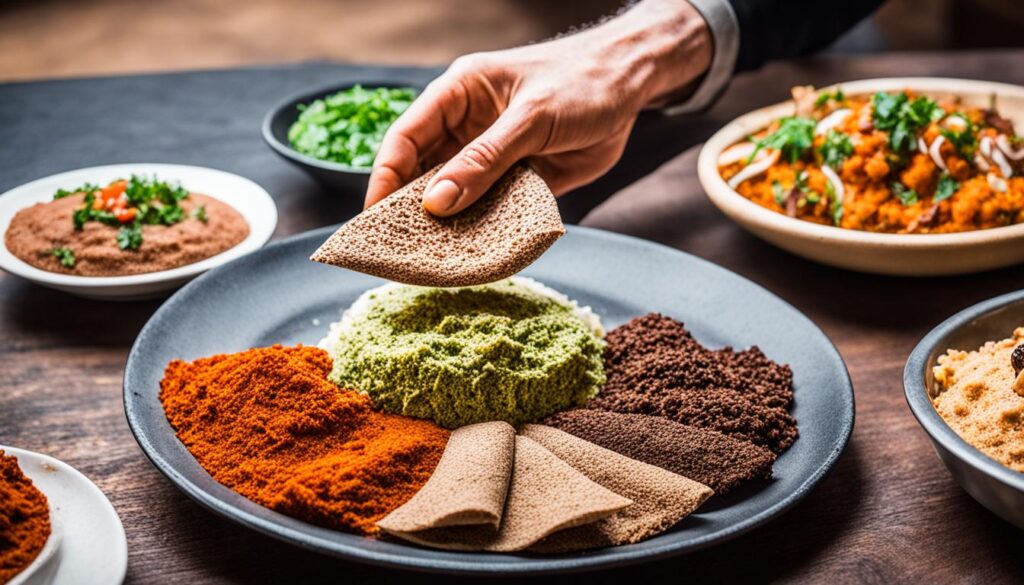
Injera, a flat and spongy bread made from teff, is a staple in Ethiopian cuisine. Teff is a grain native to Ethiopia that gives injera its unique flavor. To create injera, the batter is fermented for 1 to 3 days, resulting in a tangy taste. The fermented batter is then cooked on a hot griddle, creating a large round pancake-like bread.
Once cooked, the injera is rolled out and used as a utensil to scoop up various dishes. One such dish is wot, a traditional spicy stew made with vegetables or meat. The injera’s spongy texture and mildly sour taste perfectly complement the rich flavors of wot, making it a delightful combination.
During a traditional Ethiopian meal, injera serves as the base on which other dishes are placed. The injera is placed on a communal plate, usually about the size of a large pizza pan. The various foods, including wot, are then served and shared among the diners, who use torn pieces of injera to scoop up the flavorful bites. This communal eating experience fosters a sense of togetherness and sharing, which is an integral part of Ethiopian dining tradition.
Let’s take a moment to appreciate the visual appeal of this delectable combination:
As you can see, the injera bread is at the center of the meal, surrounded by a colorful assortment of wot and other Ethiopian dishes. The injera’s softness and flexibility make it the perfect vessel for scooping up the mouthwatering stew.
Ethiopian Dining Customs
Ethiopian dining customs revolve around communal eating and respect for elders. Meals are often shared from a large, communal plate, reinforcing the sense of togetherness and camaraderie. The act of coming together to partake in a meal is not just about satisfying hunger but also about bonding and strengthening relationships. A meal in Ethiopia is a social occasion where friends and family gather to enjoy each other’s company.
During mealtime, it is customary to wait for the elders to begin eating before starting the meal. This is seen as a sign of respect for the wisdom and experience they carry. By allowing the elders to lead the way, younger generations show appreciation for their guidance and the role they play in the community. This practice fosters a deep sense of interconnectedness and reinforces the importance of intergenerational relationships.
Another unique aspect of Ethiopian dining customs is the practice of hand-feeding, known as gursha. In this gesture, one person uses their hands to feed another person a small bite of food as a sign of friendship and respect. Gursha is a beautiful expression of the strong bonds that exist within Ethiopian society, showcasing the value placed on shared experiences and caring for one another.
In Ethiopian dining customs, communal eating and respect for elders go hand in hand. The act of sharing a meal from a communal plate fosters a sense of unity, reinforcing the idea that everyone is equal and deserving of nourishment. This tradition also encourages conversation, laughter, and the exchange of stories, creating a vibrant and lively atmosphere.
Ethiopian dining customs celebrate and honor the importance of community and kinship. By embracing these customs, we can learn valuable lessons about togetherness, respect, and the power of sharing a meal. Whether we are in Ethiopia or any other part of the world, incorporating elements of Ethiopian dining customs into our own mealtime routines can elevate our dining experiences and deepen our connections with others.
Ethiopian Food and Etiquette Tips
To fully appreciate Ethiopian food and navigate the dining experience, there are important etiquette tips to keep in mind. It is customary to wash hands before and after the meal, both as a hygienic practice and a sign of respect. Handwashing ensures cleanliness and demonstrates our appreciation for the food and culture.
When passing objects, such as utensils or dishes, it is important to use the right hand or both hands together. Using the left hand alone is considered impolite in Ethiopian culture. By using the correct hand, we show respect and adhere to traditional customs.
While strict punctuality is not expected in casual settings, being considerably late is seen as unacceptable. Arriving within a reasonable timeframe shows our commitment and consideration for others, allowing us to fully enjoy the dining experience without causing unnecessary delays.
By adhering to these etiquette tips, we can enhance the overall dining experience in Ethiopia and immerse ourselves in the rich cultural traditions that surround Ethiopian cuisine.
Conclusion
Exploring Ethiopian dining tradition is a fascinating journey into a rich and culturally significant culinary experience. The practice of eating with our hands and using injera bread as a utensil adds an element of authenticity to the dining experience. By understanding the customs and etiquette associated with Ethiopian dining, we can fully immerse ourselves in the vibrant traditions of this remarkable cuisine.
Ethiopian dining tradition revolves around communal eating, bringing friends and family together to share a meal from a large communal plate. This not only fosters a sense of togetherness but also enhances the enjoyment of the food.
As we delve into the world of Ethiopian dining, it is important to remember the significance of injera bread. Made from teff or other grains, this soft and tangy bread serves as a vessel for scooping up flavorful dishes like wot. Its unique texture and taste add a delightful element to each bite.
By embracing the Ethiopian dining tradition, we not only savor the delicious flavors but also pay homage to a cultural heritage that has been passed down through generations. So, let us embrace the practice of eating with our hands, cherish the injera bread, and embark on a culinary adventure that will leave us with lasting memories of the vibrant Ethiopian dining experience!

